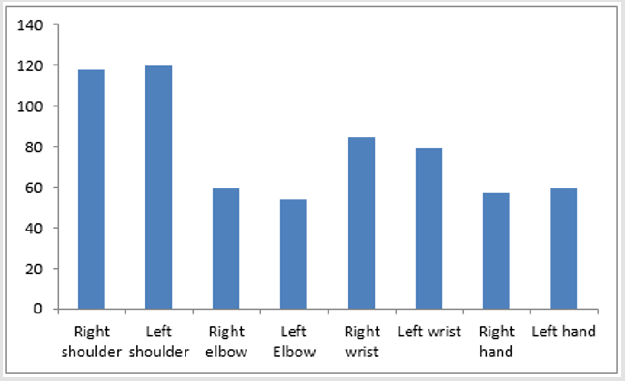Upper Extremity Pain in Spinal Cord Injury (Sci) Patients
Introduction
Spinal cord injury (SCI) can be described as an injury involving the spinal cord that can be caused by compulsion, incision or contusion. The injury leads to alterations or interruptions of spinal cord functions [1]. SCI usually is a reason for various types of disabilities in children [2]. It has been estimated that approximately 40 million people at global level are affected by SCI. The majority of these injured patients are young men. The majority of cases among children are associated with sports, particularly football [3-5]. Estimates on international level pointed out that the most frequent causes of SCI are due to traffic accidents, gunshot injuries, knife injuries, falls and sports injuries [1]. Patients with SCI usually suffer from upper extremity (UE)pain with rates varied from 26% to 96% [6-7].About 35% of patients with SCI patients had severe pain [8- 10].The pain associated with SCI has various influences including quality of life, mood, and function [11-12]. It has been indicated that with increased medical care with the persons who have SCI, the life expectancy for those patients has increased. A variety of problems are associated with SCI such as pain in the upper extremity [13].
Study objectives
To investigate the incidence of upper extremity complaints among SCI patients, and to study the predicting factors and main etiologies resulting in these complaints among patients who are followed in SCI clinic at the Royal Rehabilitation Centre, Royal Medical Services.
Methods and Subjects
Study design and setting
A retrospective design was conducted to collect data from the electronic notes of SCI patients followed in SCI clinic at the Royal Rehabilitation Centre, Royal Medical Services in a one year period of time since Jan2018 till Jan 2019.
Study sample
A total of 200 files of SCI patients were included.
Inclusion criteria
SCI patients, tetraplegic and paraplegic, classified as A, B, C, or D according to the American Spinal Cord Injury Association(ASIA), Impairment Scale between 18 to 65 years of old.
Exclusion criteria
History of upper extremity trauma, progressive disease, Rheumatological disease that may manifest as musculoskeletal problem such as Rheumatoid arthritis, Ankylosing Spondylitis and haemodialysis patient with AV fistula.
Statistical analysise
All data were entered into SPSS version 21 for statistical analysis. Data were presented as percentage, frequencies, means and standard deviations to describe study variables.
Results
Frequency of Age and Gender by Study Participants
As it can be seen in (Table 1, Figures 1 and 2), the mean age of study participants was 43.78±13.5 years, 60% of participants were males, and the prevalence of UE pain in patients with SCI was 84%.
Location and degree of severity of upper extremity pain among patients with SCI
As demonstrated in (Table 2 and Figure 3), the most frequent upper extremity pain was in shoulders, followed by wrist, elbow, and hand. Mild severity was noted in left wrist, while intermediate or moderate severity was mostly exhibited in the right elbow, and the most severity was observed in the right shoulder.
Discussion
The present study was conducted to explore the prevalence of upper extremity pain among patients SCI. Across the literature, great interest was withdrawn to problems related to musculoskeletal system among patients with chronic SCI [13-17]. The data of the present study indicated that about 84% of patients with SCI suffered from upper extremity pain. Previous studies reported varied rates of upper extremities among SCI patients. In their study, Dalyan et al [13] reported a prevalence of 58%, while Kentar et al [18] reported 81% prevalence of upper extremity pain among patients with SCI. The data of the present study showed that the most existence of upper extremity pain among patients with SCI was in shoulder and wrist. These findings are consistent with other studies in literature [13,19-22].
Conclusion
The present study showed that the prevalence of upper extremity pain among patients with SCI patients was about 84%, and the most pains were in shoulders or wrists.
For more Articles: https://biomedres01.blogspot.com/







No comments:
Post a Comment
Note: Only a member of this blog may post a comment.